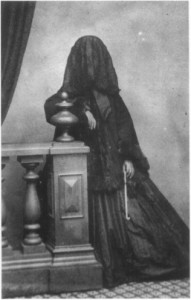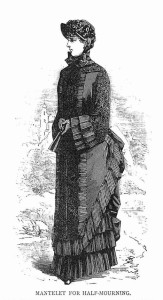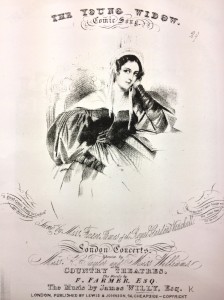 When I began my research on the literary and cultural history of the widow, I didn’t anticipate that I’d be faced with stacks of large mid-Victorian song books instead of neat volumes of fiction piled up on my desk, not least because my ability to read music has left me pretty much entirely since my enthusiastic but futile exploits at the keyboard nearly two decades ago. However, it transpired as soon as I opened the first volume that these song books would prove some of the most entertaining sources I’ve come across so far. This is not just because of the words to the songs (they are largely “comic songs”, i.e. tongue-in-cheek) but also because of the beautiful and telling colour illustrations which accompany them, illustrations that I can’t reproduce in their original quality in this series of posts for copyright reasons.
When I began my research on the literary and cultural history of the widow, I didn’t anticipate that I’d be faced with stacks of large mid-Victorian song books instead of neat volumes of fiction piled up on my desk, not least because my ability to read music has left me pretty much entirely since my enthusiastic but futile exploits at the keyboard nearly two decades ago. However, it transpired as soon as I opened the first volume that these song books would prove some of the most entertaining sources I’ve come across so far. This is not just because of the words to the songs (they are largely “comic songs”, i.e. tongue-in-cheek) but also because of the beautiful and telling colour illustrations which accompany them, illustrations that I can’t reproduce in their original quality in this series of posts for copyright reasons.
 One of my main observations about widows in Victorian literature and culture has been that they often (though by no means always) are portrayed as deviant on an economic, social, and sexual level. They were able to own their own property (beyond what the slowly changing laws allowed women at the time), and they were both sexually experienced and available for remarriage, meaning that if you were trying to arrange a match with an attractive bachelor for your daughter, you may not want a rich, independently-minded widow sat opposite that eligible specimen at the dinner table. With this combination of autonomy and experience comes a position of agency and power not usually assigned to women of the middle and upper classes. It’s the appearance of these widows in popular mid-Victorian comic songs to which this and subsequent posts are dedicated; that is, it’s concerned with widows of the charming, crafty, and complicated kind.
One of my main observations about widows in Victorian literature and culture has been that they often (though by no means always) are portrayed as deviant on an economic, social, and sexual level. They were able to own their own property (beyond what the slowly changing laws allowed women at the time), and they were both sexually experienced and available for remarriage, meaning that if you were trying to arrange a match with an attractive bachelor for your daughter, you may not want a rich, independently-minded widow sat opposite that eligible specimen at the dinner table. With this combination of autonomy and experience comes a position of agency and power not usually assigned to women of the middle and upper classes. It’s the appearance of these widows in popular mid-Victorian comic songs to which this and subsequent posts are dedicated; that is, it’s concerned with widows of the charming, crafty, and complicated kind.
“The Young Widow: A Comic Song” (1843) by F. Farmer & James Willy
 The earliest song to which I want to introduce you in this series of posts gives you a flavour of the cheeky tone of these works. “The Young Widow: A Comic Song” (1843) is told through the voice of a woman who advertises herself to new suitors by telling them (and us) of what she considers her many attractive qualities, which the song reveals to be not attractive at all. That there is something deviant about this widow becomes clear to a Victorian audience as early as the first verse, where we learn that our widow’s late husband in fact only died six months ago. A middle- or upper-class widow in the mid-Victorian period would have been expected to go into “deep mourning” and shun the vast majority of social occasions for at least one year, with two more six-months periods of “half mourning” and “light mourning” and an easing back into society to follow (here blacks turned into shades of grey and lighter fabrics were allowed). However, here’s what “The Young Widow” tells us in the song’s first three verses:
The earliest song to which I want to introduce you in this series of posts gives you a flavour of the cheeky tone of these works. “The Young Widow: A Comic Song” (1843) is told through the voice of a woman who advertises herself to new suitors by telling them (and us) of what she considers her many attractive qualities, which the song reveals to be not attractive at all. That there is something deviant about this widow becomes clear to a Victorian audience as early as the first verse, where we learn that our widow’s late husband in fact only died six months ago. A middle- or upper-class widow in the mid-Victorian period would have been expected to go into “deep mourning” and shun the vast majority of social occasions for at least one year, with two more six-months periods of “half mourning” and “light mourning” and an easing back into society to follow (here blacks turned into shades of grey and lighter fabrics were allowed). However, here’s what “The Young Widow” tells us in the song’s first three verses:
Now all single Gents I address myself to
And hope they will all pay attention
In the first place allow me to ask how you do
And weigh well in your minds what I mention
My husband has now been dead six months at least
And seriously now I consider
‘Tis folly to mourn so for one that’s deceas’d
And I can’t bear to be
And I can’t bear to be
And I can’t bear to be a Young Widow
Now young men look sharp there’s no time to lose,
Half mourning I put on tomorrow
Look at me – just hear me – you cannot refuse,
I’ve only six months left for sorrow.
What an odious custom to wait for a year,
For one’s feelings they do not consider;
To lose so much time – it’s quite horrid – oh dear!
So long – I’ll not be a Young Widow
They say ‘tis not decent to marry too soon,
And to dress in no color but sable,
I’ll not be convinc’d they may talk to the moon,
Me mourn for a year! I’m not able;
Besides my good man who is now dead and gone
For my comfort would always consider,
I’m sure he don’t wish me to live so forlorn:
Therefore now then who’ll have a Young Widow.
 Her active pursuit of a new a new husband so shortly after her late partner’s death indicates that this young widow does not keep with convention and is failing – quite consciously so – to show the respect that society would have required of her, for propriety’s sake. As Pat Jalland has pointed out, the prescribed period of mourning was assumed to “approximate to the period of personal grief” (300), yet our “young widow” here – in however “comical” or deviant a way – raises a valid concern over that problematic standardization of the period of grief that suggested that every widow mourns her husband for the same length of time, outwards as well as inwards. But it’s not genuine concern or social critique the song conveys in this case. As its cover illustration cleverly indicates, our young widow is distracted by something outside of the picture (see image on the left). She is not focused on the here and now or even her marital past, but seems to be coyly flirting with the future by glancing sideways at something outside of the image.
Her active pursuit of a new a new husband so shortly after her late partner’s death indicates that this young widow does not keep with convention and is failing – quite consciously so – to show the respect that society would have required of her, for propriety’s sake. As Pat Jalland has pointed out, the prescribed period of mourning was assumed to “approximate to the period of personal grief” (300), yet our “young widow” here – in however “comical” or deviant a way – raises a valid concern over that problematic standardization of the period of grief that suggested that every widow mourns her husband for the same length of time, outwards as well as inwards. But it’s not genuine concern or social critique the song conveys in this case. As its cover illustration cleverly indicates, our young widow is distracted by something outside of the picture (see image on the left). She is not focused on the here and now or even her marital past, but seems to be coyly flirting with the future by glancing sideways at something outside of the image.
However, as eager she is to remarry, it soon transpires that she is perhaps not “the bargain” she makes herself out to be. Playing on the independence and experience of a widow and on her ability to freely choose her new partner, the young widow – unlike a young woman who is to be married for the first time – is not as easily molded to the requirements of a new husband; rather, her new husband will have to obey her wishes and needs, both intellectually and domestically, reversing the Victorian middle-class roles of wife and husband:
But I think it quite fair ere the bargain I seal,
To state I require due submission,
The husband I choose must serve me with zeal:
And then there’s another condition,
He must rise, light the fire, the Breakfast prepare,
Boil the Eggs, make the Toast, and consider
That I must be Master, or else I declare,
I would rather remain a Young Widow.
He must not contradict if I say cold is hot,
Black must be white at my pleasure,
Or by chance at his head he may have a the Tea-pot:
Then young men don’t miss such a treasure;
Such sweetness of temper you’ll ne’er meet as mine,
Of a young woman’s troubles come rid her,
Now don’t all speak at once, only one at a time,
You must wait till again I’m a Widow.
As the last lines indicate, the widow is a “treasure” only in her own eyes, but not in the eyes of society, and especially not in the eyes of eligible men. What the song evidences quite clearly is the uneasy association – however comical – of widows with an “unattractive” independence of both means and mind, a power which results in the emasculation (and even feminization) of any future husbands. The plural is important here, of course, as the final line chillingly reminds any male suitors that they may be only one in a long line of dead husbands; the widow’s power, then, may drive any future suitor to the grave.
Resources
F. Farmer & James Willy, “The Young Widow: A Comic Song” (1843) [Complete song]
Pat Jalland, Death in the Victorian Family (1996) [Google Books preview]
“Mantelet for Half-Mourning”, The Ladies’ Treasury: A Household Magazine (1 Oct 1883), p. 591 [Full article]
“Mrs Howes in Deep Mourning” (ca. 1860 – 1870) [Museum of the City of New York]
Richard Redgrave, “Throwing Off Her Weeds” (1846) [Victoria & Albert Museum]
James Jacques Joseph Tissot, “A Widow” (1868) [James Tissot: The Complete Images]